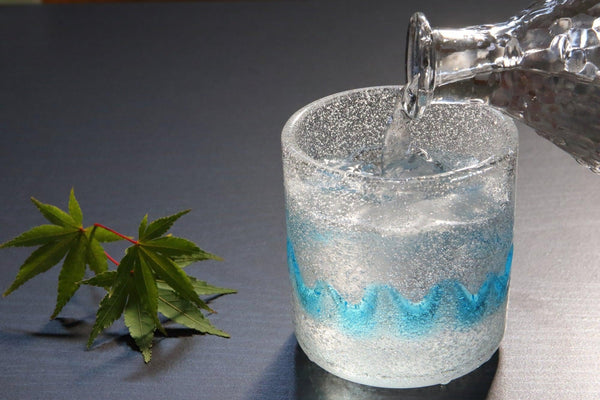
Jump to:
When most people think of Japanese liquor, the two types that immediately come to mind are Nihonshu (commonly known as “sake”), and Shochu. You may be less familiar with Awamori, a popular liquor from the island of Okinawa. Awamori (sometimes called Shima-zake, or island sake, in Okinawa) has been made in the same way for over 500 years, using only rice, Koji mold, water, and yeast.
In this article, we will look at what Awamori is and how it is made, including how it differs from Nihonshu and Shochu, as well as their respective alcohol contents. (Note that although some people classify Awamori as a type of Shochu, in this post Shochu will refer to non-Awamori Shochu.) We shall also look at the history of Awamori, different types (including some with exotic ingredients), and popular ways of drinking it, as well as foods with which to enjoy it, focusing on its link to Okinawan culture.
What Is Awamori?

Perhaps the best way of describing what kind of liquor Awamori is, is by looking at the way it is both similar to and differs from Nihonshu and Shochu. Here, we will compare them in terms of ingredients, method of production, and the type of koji (rice mold) used.
Both Nihonshu and Awamori use rice as their base ingredient. Shochu may use rice, but alternatively may use other ingredients such as barley or potatoes. Whereas Nihonshu uses Sakamai (or sake rice), however, Awamori uses Indica, long-grained Thai rice (there are historical reasons for this that will be discussed later).
Whereas Nihonshu is brewed, Shochu and Awamori are distilled rice liquors. However, whereas Shochu usually uses two fermentations, Awamori is always made in a single fermentation.
Other differences come with respect to the type of Koji used. This is the bacterium Aspergillus oryzae that breaks down the starches in the base ingredient into alcohol during fermentation. For both Nihonshu and Shochu, black, white, or yellow Koji may be used, but Awamori uses only black Koji. As black Koji produces a large amount of citric acid, this is highly effective at suppressing decay caused by germs, making it ideal for the warm, humid climate of Okinawa.
How Is Awamori Made?

First, Indica Thai rice is soaked in water, before being sprinkled with black Koji mold, to make rice koji. Water and yeast are then added to the Koji to make a Moromi or mash, which is then fermented for approximately two weeks in a process known as “whole koji preparation” (or Zen-Koji Shikomi) in Japanese. It then undergoes a single distillation, typically using a distillation machine that circulates the Moromi, allowing the ingredients to blend well with the steam. Check out these articles if you are interested in learning more about Koji and Moromi.
Kusu (literally “old liquor”) is the name for Awamori that is aged by means of long-term preservation in clay pots. Its flavor improves and becomes more mellow as time goes on. Previously, there were Kusu that were aged for over a century, but most of these were lost in World War II. You can still find Awamori aged for 20-30 years today, and these come with a hefty price tag.
To qualify as Kusu, Awamori must be at least three years old.
Awamori has a mellow earthy flavor with a rice fragrance and a slightly sweet aftertaste. As it ages, and becomes Kusu, the vanilla-like sweet taste is enhanced, and it starts to develop fruity and citrusy notes, although some Kusu is more akin to chocolate or coffee.
Alcohol Content Of Awamori
The advice to “drink responsibly” is perhaps more apt when it comes to Awamori than with any other Japanese liquor. Unlike Nihonshu where the alcohol content is deliberately watered down to around 13-17% to make it more drinkable, traditionally the alcohol content of Awamori is 30-40% by volume, putting it on a par with spirits such as vodka and tequila, and making it a fair bit stronger even than Shochu (generally around 25%). There are also types, discussed later, that are even stronger.
In recent years, however, the alcohol content has been reduced in certain exported versions (including mainland Japan) or fruitier versions aimed at young women. These may be infused with flavors, such as the traditional Okinawan citrus fruit Shikuwasa, passion fruit, and plum.
History Of Awamori
Previously, we mentioned that Awamori was made using Indica Thai rice rather than Japanese rice, and there are historical reasons for this. In the 15th Century, when Awamori was invented, Okinawa was actively trading with Asia, and the technique of distilling was introduced from the Kingdom of Siam (present-day Siam). This also explains why Thai crushed rice is used. The Okinawans, borrowing distillation techniques from neighboring countries, refined the process and discovered the benefits of using black Koji mold, and this created the unique taste of Awamori that is still loved today.
Types Of Awamori
In addition to standard Awamori, the aged Kusu, and the fruitier flavor-infused Awamori discussed previously, there are various variations on this ancient liquor that you may wish to try depending on how adventurous you are feeling.
Hanasake

Literally “flower liquor”, this type of Awamori is only produced on the Okinawan island of Yonaguni. It is extremely strong, with an alcohol content of approximately 60%. It was named for the fact that, in ancient times, the alcohol content was judged by pouring it into a glass from a certain height and judging how much foam was produced. As the foam resembled a blooming flower, it was named “Hanasake”. This is traditionally drunk straight, but unless you can really take your liquor, it is advised that you drink with extreme care.
Habushu

This is certainly one for people with more exotic tastes. Also known as “Okinawan snake liquor”, a whole Habu, or pit viper, is put into a bottle containing Awamori, herbs, and honey to produce a yellowish liquid. The renowned mating prowess of the snakes in question has led to the belief that the liquor has libido-boosting benefits. The Habu is killed in one of two ways, neither of which is much fun for the snake in question, so animal lovers may wish to avoid this particular delicacy.
Koregusu

Koregusu is used as a condiment rather than a drink, in which chili peppers are soaked in Awamori, and the resulting liquid is used by Okinawans to add spice to a variety of dishes, including fried rice, Okinawan soba, Chanpuru, sashimi, and miso soup. If you are not a big drinker but enjoy spicy food, this is a great way of experiencing the flavor of Awamori.
Ways Of Drinking Awamori

Awamori is traditionally drunk from small clay cups called Chibuguwa. The idea is to drink it slowly in sips rather than drinking it down in one gulp.
Often when drunk in restaurants in Okinawa, it will be accompanied by a carafe of water and an ice container.
You can drink it straight or mixed with cold water (Mizuwari) or hot water (Oyuwari), on the rocks.
Being a colorless distilled liquor, it is also perfect for mixing in cocktails and in addition to the fruit-infused Awamori, previously described, standard Awamori can be enjoyed in cocktail form with sour citrus fruits, such as lemon and Shikuwasa, or sweet tropical fruit, such as mango.
If you are splashing the cash for aged Kusu, however, the only way to drink it is straight, sipping it slowly to truly enjoy its rich flavor.
What Foods Go Well With Awamori

Awamori can be enjoyed with a wide range of Okinawan, mainland Japanese, Chinese, and European dishes. Although produced with rice, its distinctive production process, involving a single distillation means that it has a more robust flavor than rice-based Shochu, and its unique aroma and rich flavor mean that it goes particularly well with spicy and heavier foods, including cheese or cream-based dishes such as lasagna.
It pairs particularly well with fried foods and fatty meats, so is a great accompaniment to Okinawan dishes such as Champuru, Rafute, which is pork belly slowly simmered in a sweet and savory sauce, spicy pork ribs, and banana fritters.
Where Can I Drink Awamori?
If you are in Okinawa, the best place to try Awamori is in an Okinawan izakaya (a kind of cross between a pub and a restaurant). Most izakaya will have a wide range of varieties available for a variety of prices.
You can also taste Awamori by going on a tour of a distillery. However, it should be noted that these are not offered all the time, so it is probably best to call and check in advance.
If you are not able to make it to Okinawa, you will find Awamori available in many bars and izakaya in Tokyo and other parts of Japan as well.
Until now, Awamori has not been very well-known outside of Okinawa and Japan, but slowly but surely international exports have increased to the point where it is getting a loyal following in many countries. However, international consumption still only accounts for 0.2% of the total.
Awamori – The Okinawan Liquor

As discussed, the traditional Okinawan liquor of Awamori is not for the faint-hearted as it is at least twice the strength of most Nihonshu, and a good deal stronger than other Shochu as well. However, traditionally Okinawan in that it draws heavily on the external influences prevalent when it was first created, in terms of the type of rice used and distilling techniques used, it offers a different perspective on Japanese liquor that you might like to try (with due care) if you enjoy alcohol. As previously mentioned, some lower alcohol varieties have been produced if you don’t wish to go the whole hog, and there are even ways of enjoying the flavor of Awamori without the alcohol, such as in condiments such as Koregusu.
Have you tried Awamori yet (including some of the more exotic varieties)? Let us know in the comments what you think of Awamori.


0 comments